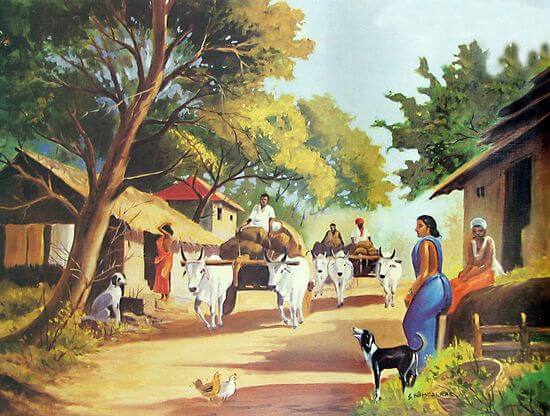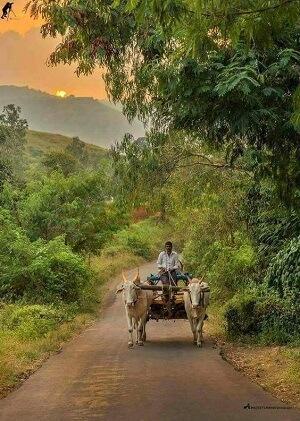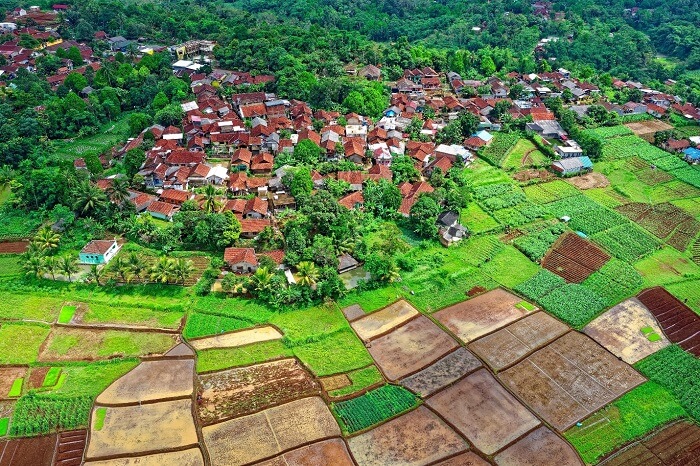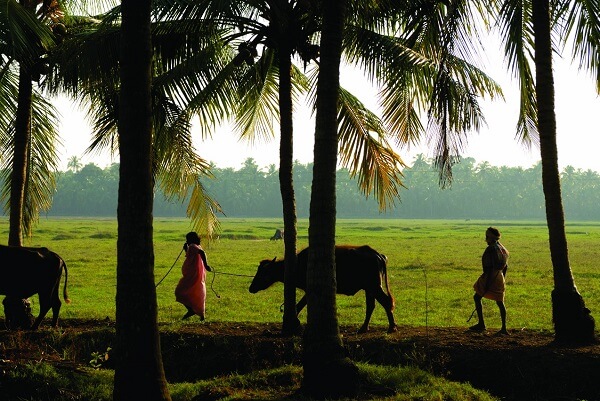My Village EssayVillage! As soon as you read this word, what comes into your mind is fresh air, peace, organic vegetables, fresh milk, and the scene of a settlement having simple houses, with much greenery compared to cities, surrounded by farms, and a river flowing creating a beautiful scenery while the dawn and dusk. This is the natural beauty of the villages. There you will find many people engaged in various activities for their living. Some are into household workshops, some in agriculture, some in cottage industries, etc. 
How is a Village Formed?Being settled is the first building block in the process of formation of the villages. Villages were set up by a group of few people of the same community near rivers to get water to drink and fertile land to grow. Earlier settlements were either tiny hamlets with thatched huts or large settlements with roofs tiled or houses made of bricks. As the time passed, these small settlements of 5 - 6 houses expanded to villages of about 500 families of people from various communities engaged in multiple occupations. However, villages come under the rural areas of a country. And the rural area is defined as more than 75% of the population performing an agriculture-related activity. Villages are said to be the backbone of the Indian economy due to their significant contribution to the primary sector of agricultural production for our country. 
The river is the reason for the settlement. It gives the soil fertility and thus provides the human with their living. Fertile soil for growing crops, with water available for irrigation, is considered to be the best combo, which led to villages being set. The wet soil has a pleasant fragrance, which calms our minds. The river is the water source for every single purpose in the town. It also gives the fishermen community their bread through the aquatic life present in it. The fresh river water is sweet; it has its natural sweetness, which cannot be found anywhere in packaged drinking water. Life and Progress in Villages:The foreign artists and filmmakers have formed an impression through their work that the Indian villages are just clusters of mud-plastered walls, given shade by trees and bullock carts used for transport. They depict it in a manner such that the viewer will automatically get sympathy after seeing it. They showcase the village woman as delicate, holding an earthen pot on her head, and walking very comfortably. The children are shown to be malnourished. In all, poverty is shown in the atmosphere created. But, the reality is way too different from the past few decades; the village is a centre of non-stop work. Villagers were considered to be following the primitive forms of survival, but it is not the case now. Modern techniques, technology, and ideas have reached the villages, though they are yet to create an impact as in cities. People in villages have initiated practising other occupations to increase their income during the off-season on farms. Many of the villagers have a good annual income. The people here are very much skilled, and they know many kinds of daily chores. Because, unlike the cities, there is no one other than themselves as a helping boy or staff. They help each other in many daily jobs, sometimes in farming, i.e., during sowing or harvesting. The villagers will treat you as their family even if they don't know you; this is their simplicity. Village Homes and Life Style:Life in the village is filled with contentment and happiness, as people are never in a hurry like those in cities. Simplicity can be seen in every aspect of their life; they live in simple houses, eat simple food, wear simple clothes, and, in short, live a simple life. The homes found here are of two types, Kutcha and Pucca. 
The Kutcha house is located in the majority, and the Pucca house is located either very few or not at all. The Kutcha houses have thatched roofs and are made up of mud, wood, straw, bamboo leaves, grass, etc., with many windows and a large courtyard. The Pucca house, as the name suggests, is made up of bricks. The homes, as said, have a yard where plants of flowers, fruits, and some veggies are grown for household consumption; somewhere, the domestic animals owned are also tied in the yard. Some houses also have separate space allotted for this very purpose. They also have a granary to store their agricultural produce before selling them. The green farms fed by the water give the whole nation its meal. There are wide different varieties of plants and crops grown on the farms, such as wheat, rice, vegetables, fruits, oil seeds, cotton, etc. These farms are worked on by the villagers and their domesticated animals or machines. In some regions, after the cropping season, the field is given to groups that practice pastoralism. This gave pastoralists a place for their livestock to feed on and a service to the landowners of regaining the nutrients through the waste of the animals. This practice is nowadays getting less practised due to lesser transhumance by the pastoral communities. They are now adopting the modern ways of settlement and livelihood. Modernization is reaching the villages too. It can be seen in many aspects of life in the village. The villages beside the river are now modernized with tractors running in the field, electricity in houses, and mobile networks of various broadband available. A TV box in each household now replaces the radios. The villagers have seen days before 2000 when each village would have just one or no TV. Gone are the days when the men or women of each household used to go to the nearby forest to collect wood for fuel. And the ladies used to cook continuously, coughing in the smoke. Also, the other side effects of fuel wood were not left out. The LPG gas cylinders now replace this fuel wood in much of the country's rural areas. Various electronic equipment is also now reached in many of the villages. The most fundamental and widely wanted transformation is the use of toilets in the personal household rather than defecating in the open. This has led to a remarkable change in the level of hygiene and reduced the number of diseases caused by the villagers. Some Challenges for Villages:Free of the pollution, dirt, crowd, hustle, and bustle, villages give peace and a refreshing environment to live in. Nothing in this world exists without its disadvantages. Due to the lower population, many of the public amenities, such as the higher education institution (pre-primary and primary level schools are mainly found nowadays, they might lack in some very backward villages), Public Healthcare Centers, Banks, ATMs, Petrol fueling stations and other are not preferred to be catered in over here. But, some of the villages are not provided with the services of the post office, police outposts, etc. Apart from all these, the major demerit is the lack of employment opportunities in the rural areas. Those villagers owning less land do not get sufficient from that land, so they migrate to the urban areas. Some well-to-do people also migrate to cities to get quality services of education, health, etc., and convenient life. But although deprived of facilities, the village life is contended and happy in all. Some Interesting Facts:Hence, many modern-day facilities are not present in the villages, but they are a wonderful place to get more energy from the birds; their sweet melodious sound fascinates our minds. The scenes of the dawn and dusk describe the beauty of nature every single day. It gets even enhanced in the spring when flowers and fruits bloom. The essence spread by the soil after the rain is mesmerizing, and one feels to capture the smell until it arrives the following year. Not only is the monsoon blessed, but we can also receive the best air conditioner in the slow breezes blowing in the summers. And the exposed sunlight is in the purest form in winters However, with technologies seeping into villages these days, it cannot be said that the towns host a pollution-free environment. But comparatively, the percentage is lower here. As the saying goes, "Village life is much more than just living in the same place. It's about your connections with other people and how it feels to belong somewhere." They give us beautiful experiences alongside the natural resources about how to get everything from limited resources. People here are vibrant with innovative ideas for their regular work. They have sympathy for all. As the saying goes, "Village is the only place in the world where people love each other unconditionally." 
The evening here is entirely holy. The hectic day of the villagers ends with prayers in the village temple, which generally lies on the outskirts of the village. All the villagers come here. After the prayer gets over, the men and the elderly get indulged in talks on topics that could never be imagined. And the children run here and there playing after a day full of study and helping elders. There is a specialty of villages concerning children. Here children grow up very steadily and need not be taught vocational skills, especially by paying. They get to see many of these in their locality itself, and if interested, they get into it. Yes, some technicalities might be missed, but they capture much knowledge. In villages, children grow up along with others of their age. They learn together in school, go to school together, play together, and celebrate all the festivities together. Togetherness is not just in the kids. It is seen in most aspects of rural life. The decisions here are made collectively through panchayat meetings. According to the Panchayati Raj System, the gram panchayat takes care of the welfare of the village. All the issues are solved in the meetings with the majority and as per suitability. It has various impacts. The elder children get exposed to governmental activities, this can develop children's interest in governance and or politics, the people can select leaders, who they know very closely, and most importantly, the problem gets solved in the minimum time possible as nothing goes to the city level administration. Hence no matter what the issue is, it is first looked at the panchayat level, let it be security, food, education, irrigation, loan, etc. Safety is, by the way, looked out for by the police. To date, not every village has a police station, but it is not too far away. There is minimal possibility of police interference in any matter, as simple and decent villagers are united by mutual love and fellow feeling, stand by one another in times of need, and solve the problem by mutual understanding. Festivals are the major entertainment area of the villagers. Indian festivals are generally based around the cropping seasons, and it gives the villagers immense satisfaction, joy, and happiness to celebrate them after completing their farm work. They do not regret it even if they don't have the modern socializing and entertainment facilities as in cities. Still, they have an extraordinary social life with occasional pujas, yatras and melas, which last for weeks. Hence, it is rightly said that the "Indian village is the backbone of Indian cultural identity." The central part in the celebrations of various festivals is not within their own family, but within the whole village as a family as they understand that happiness is to be spread to increase and sorrow is to be distributed to reduce. Hence a village celebrates the sum of its parts, not the individual components themselves. That is why many city dwellers return to their villages to celebrate the festivals in their proper form of rituals and enjoyment. ConclusionSumming it up, all at once, villages are the place where peace, love and harmony stay in the very vicinity where the villagers reside. Distinct experiences from four different seasons let us experience the absolute joy of peace. Away from irritating traffic sounds, crowds, and villages are far better to live a healthy life. Villages can be the best location for students to study with total concentration and with no distractions. They are also very beneficial from the health perspective to stay in villages due to low polluted environment. It plays a significant role in maintaining the ecological balance of the villages. It provides us with the best version of all of our needs, be it water, air or food, without any processing and added value. As the environment, so the people. They might be poor by money, but they are the richest by heart. The special significance of moral values can be seen in the villages; hence, the children grow up in a healthy and sound environment, with deep knowledge of our culture and heritage.
Next TopicTeachers Day Essay
|
 For Videos Join Our Youtube Channel: Join Now
For Videos Join Our Youtube Channel: Join Now
Feedback
- Send your Feedback to [email protected]
Help Others, Please Share









